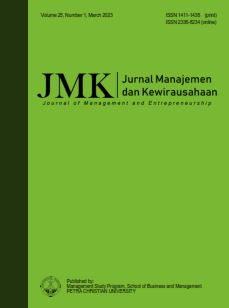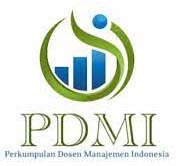THE INFLUENCE OF CUSTOMER INSPIRATION ON SOCIAL MEDIA MARKETING TOWARD ARCHITECTURAL SERVICE PURCHASE INTENTION
DOI:
https://doi.org/10.9744/jmk.25.1.13-24Keywords:
Customer inspiration, purchase intention, utilitarian content, hedonic content, opennessAbstract
Social media has been used as a marketing tool by architecture firms to generate purchase intention. However, inspiration as a motivating internal response is needed to achieve the marketing objective. This study aims to examine the effect of utilitarian content, hedonic content, and openness as antecedents of customer inspiration, the effect of customer inspiration on purchase intention, and the mediating role of customer inspiration between antecedents and purchase intention. A total of 395 respondents were taken as samples using simple random sampling, and the data was then analyzed with SmartPLS. Results show that utilitarian content, hedonic content, and openness positively affect customer inspiration, and customer inspiration positively affects purchase intentions. Additionally, customer inspiration also mediates the effect of utilitarian content, hedonic content, and openness on purchase intentions. This study contributes to the literature on customer inspiration from a customer-firm relationship perspective. Moreover, this study can give insight for architectural firms to effectively practice social media marketing by focusing on creating customer inspiration through the content provided and targeting the right potential customers in order to generate architectural design service purchase intention.
References
Agung, N. F. A., & Darma, G. S. (2019). Opportunities and challenges of instagram algorithm in improving competitive advantage. International Journal of Innovative Science and Research Technology, 4(1), 744–745.
Alalwan, A. A., Rana, N. P., Dwivedi, Y. K., & Algharabat, R. (2017). Social media in marketing: A review and analysis of the existing literature. Telematics and Informatics, 34(7), 1177–1190. doi:10.1016/j.tele.2017.05.008
Amaro, S., Duarte, P., & Henriques, C. (2016). Travelers’ use of social media: A clustering approach. Annals of Tourism Research, 59, 1–15. doi:10.1016/j.annals.2016.03.007
An, D., & Youn, N. (2018). The inspirational power of arts on creativity. Journal of Business Research, 85, 467–475. doi:10.1016/j.jbus res.2017.10.025
Anggraini, K., & Widodo, A. (2020). Peran teknologi komunikasi dalam pemasaran produk perbankan pada konsumen di pt dwi cermat Indonesia Jakarta. Jurnal Sekretari & Administrasi (Serasi), 18(1), 59–72.
Bahfein, S. (2022). Properti di Jawa Barat paling banyak dicari. Retrieved September 5, 2022. https://www.kompas.com/properti/read/2022/09/05/140000821/properti-di-jawa-barat-paling-banyak-dicari
Bottger, T., Rudolph, T., Evanschitzky, H., & Pfrang, T. (2017). Customer inspiration: Conceptualization, scale development, and validation. Jour-nal of Marketing, 81(6), 116 –131. doi:10.1509/jm.15.0007
Cochran, W. G. (1977). Sampling techniques. Third Edition. New York, NY: John Wiley & Sons.
Cohen, J. (1988). Statistical power analysis for the behavioral sciences. Second Edition. Hillsdale, NJ: Lawrence Erlbaum Associates, Publishers.
Colliander, J., & Marder, B. (2018). 'snap happy’ brands: Increasing publicity effectiveness through a snapshot aesthetic when marketing a brand on Instagram. Computers in Human Behavior, 78, 34–43. doi:10.1016/j.chb.2017.09.015
Ducoffe, R. (1996). Advertising value and advertising on the web. Journal of Advertising Research, 36, 21–35.
Duffett, R. G. (2015). Facebook advertising’s influence on intention-to-purchase and purchase amongst millennials. Internet Research, 25(4), 498–526. doi:10.1108/IntR-01-2014-0020
Fajriyah, H., & Marsudi, M. (2021). The effect of social media instagram promotion on the sale of mariposa novel. Jamanika (Jurnal Manajemen Bisnis dan Kewirausahaan), 1(4), 1–10. doi:10.22219/jamanika.v1i1.160 73
Fornell, C., & Larcker, D. F. (1981). Evaluating structural equation models with unobserable variables and measurements error. Journal of Marketing Research, 18(1), 39–50. doi:10.2307/3151312
Ghafourzay, H., & Parıltı, N. (2020). The impact of social media marketing on customer inspiration and customer purchase intention: A case study on Kabul-Afghanistan telecom industry. Journal of Business Research - Turk, 12(3), 2721–2732. doi:10.20491/isarder.2020.1003
Ghouri, A. M., Kin, T. M., Yunus, N. K. bin Y., & Akhtar, P. (2019). The dataset for validation of customer inspiration construct in Malaysian context. Data in Brief, 25, 1–7l. doi: 10.1016/j.dib.2019.104131
Hair, J. F., Hult, G. T. M., Ringle, C. M., & Sarstedt, M. (2017). A primer on partial least squares structural equation modeling (PLS-SEM). Second Edition. Los Angeles, CA: Sage Publications. doi:10.1080/1743727x.2015.1005806
Hair, J. F., Risher, J. J., Sarstedt, M., & Ringle, C. M. (2019). When to use and how to report the results of PLS-SEM. European Business Review, 31(1), 2–24. doi:10.1108/EBR-11-2018-0203
Hazari, S., Bergiel, B. J., & Sethna, B. N. (2017). Hedonic and utilitarian use of user-generated content on online shopping websites. Journal of Marketing Communications, 23(6), 572–591. doi:10.1080/13527266.2016.1143383
He, M., Liu, B., & Li, Y. (2021). Tourist inspi¬ration: How the wellness tourism experience inspires tourist engagement. Journal of Hos¬pitality and Tourism Research, 20(10), 1–21. doi:10.1177/ 10963480211026376
Izogo, E. E., & Mpinganjira, M. (2020). Beha¬vi¬oral consequences of customer inspiration: The role of social media inspirational content and cultural orientation. Journal of Research in Interactive Marketing, 14(4), 431–459. doi:10.1108/JRIM-09-2019-0145
Kapoor, K. K., Tamilmani, K., Rana, N. P., Patil, P., Dwivedi, Y. K., & Nerur, S. (2018). Advances in social media research: Past, present and future. Information Systems Frontiers, 20, 531–558. doi:10.1007/s10796-017-9810-y
Kepios. (2022). Digital 2022: Indonesia. Retrieved June 4, 2022. https://datareportal.com/reports/ digital-2022-indonesia
Khan, I. (2022). Do brands’ social media marketing activities matter? A moderation analysis. Journal of Retailing and Consumer Services, 64, 1–9. doi:10.1016/j.jretconser.2021.102794
Khan, M. R., & Ghouri, A. M. (2018). Enhancing customer satisfaction and loyalty through customer-defined market orientation and Customer inspiration: A critical literature review. International Business Education Journal, 11(1), 25–39. doi:10.37134/ibej.vol11.1.3.2018
Khoi, N. H., Phong, N. D., & Le, A. N. H. (2020). Customer inspiration in a tourism context: an investigation of driving and moderating factors. Current Issues in Tourism, 23(21), 2699–2715. doi:10.1080/13683500.2019.16 66092
Kim, A. J., & Ko, E. (2012). Do social media marketing activities enhance customer equity? An empirical study of luxury fashion brand. Journal of Business Research, 65(10), 1480–1486. doi:10.1016/j.jbusres.2011.10.014
Kwon, J., & Boger, C. A. (2021). Influence of brand experience on customer inspiration and pro-environmental intention. Current Issues in Tourism, 24(8), 1154–1168. doi: 10.1080/13683500.2020.1769571
Lamudi. (2021). Tren pasar properti Lamudi.co. id H1 2021. Retrieved November 18, 2022. https://www.lamudi.co.id/journal/tren-pasar-properti-h1-2021/
Leonard, B. (2022). Beli rumah jadi atau bangun rumah sendiri? Ini pilihan masyarakat Indonesia. Retrieved August 27, 2022. https://www.rumah.com/panduan-properti/beli-rumah- jadi-atau-bangun-rumah-sendiri-ini-pilihan-masyarakat-indonesia-62722
Li, F., Larimo, J., & Leonidou, L. C. (2021). So¬cial media marketing strategy: Definition, conceptualization, taxonomy, validation, and future agenda. Journal of the Academy of Marketing Science, 49, 51–70. doi:10.1007/s11747-020-00733-3
Liang, J., Chen, Z., & Lei, J. (2016). Inspire me to donate: The use of strength emotion in donation appeals. Journal of Consumer Psycho-logy, 26(2), 283–288. doi:10.1016/j.jcps.2015.09.001
Libaque-Saenz, C., Hernani, M., & Noel, G. (2019). Antecedents and consequences of customer inspiration: An empirical study in the context of electronic devices. A Paper Presented in the Conference: Encontro Da ANPAD (EnANPAD), Sao Paulo, Brazil.
Meier, A., Gilbert, A., Börner, S., & Possler, D. (2021). Instagram inspiration: How upward comparison on social network sites can contribute to well-being. Journal of Communication, 70(5), 721–743. doi:10.1093/JOC/JQAA025
Meier, A., & Schäfer, S. (2018). Positive side of social comparison on social network sites: How envy can drive inspiration on instagram. Cyberpsychology, Behavior, and Social Networking, 21(7), 411–417. doi:10.1089/cyber.2017.0708
Misra, S. K., Mehra, P., & Kaur, B. (2019). Factors influencing consumer choice of celebrity endorsements and their consequent effect on purchase decision. International Journal on Emerging Technologies, 10(2), 392–397.
Moghavvemi, S., Woosnam, K. M., Paramanathan, T., Musa, G., & Hamzah, A. (2017). The effect of residents’ personality, emotional solidarity, and community commitment on support for tourism development. Tourism Management, 63, 242–254. doi:10.1016/j.tourman.2017.06.021
Oleynick, V. C., Thrash, T. M., LeFew, M. C., Mol-dovan, E. G., & Kieffaber, P. D. (2014). The scientific study of inspiration in the creative process: Challenges and opportunities. Frontiers in Human Neuroscience, 8, 1–8. doi:10.3389/fnhum.2014.00436
Onofrei, G., Filieri, R., & Kennedy, L. (2022). Social media interactions, purchase intention, and behavioural engagement: The mediating role of source and content factors. Journal of Business Research, 142, 100–112. doi:10.1016/j.jbusres.2021.12.031
Ozkan, G., & Gurbuz, I. B. (2021). A holistic approach in explaining farmers’ intentional behaviour on manure waste utilization. New Medit, 20(3), 101–117. doi:10.30682/NM2103G
Parks-Leduc, L., Feldman, G., & Bardi, A. (2015). Personality traits and personal values: A meta-analysis. Personality and Social Psychology Review, 19(1), 3–29. doi:10.1177/1088868314538548
Rauschnabel, P. A., Felix, R., & Hinsch, C. (2019). Augmented reality marketing: How mobile AR-apps can improve brands through inspiration. Journal of Retailing and Consumer Services, 49, 43–53. doi:10.1016/j.jretconser.2019.03.004
Saxena, A., & Khanna, U. (2013). Advertising on social network sites: A structural equation modelling approach. Vision: The Journal of Business Perspective, 17(1), 17–25. doi:10.1177/0972262912469560
Shareef, M. A., Mukerji, B., Dwivedi, Y. K., Rana, N. P., & Islam, R. (2019). Social media marketing: Comparative effect of advertisement sources. Journal of Retailing and Consumer Services, 46, 58–69. doi:10.1016/j.jretconser.2017.11.001
Sharma, A., Fadahunsi, A., Abbas, H., & Pathak, V. K. (2022). A multi-analytic approach to predict social media marketing influence on customer purchase intention. Journal of Indian Business Research, 14(2), 125–149. doi :10.1108/JIBR-08-2021-0313
Sheng, H., Yang, P., & Feng, Y. (2020). How to inspire customers via social media. Industrial Management and Data Systems, 120(6), 1041–1057. doi:10.1108/IMDS-10-201 9-0548
Simamora, S. B. (2021). Pengaruh informativeness value dan entertainment value terhadap customer inspiration dan dampaknya pada purchase intention (Survei pada masyarakat kota DKI Jakarta yang menonton iklan J3K gojek). Thesis. Universitas Brawijaya, Malang.
Sugiyono. (2019). Metode penelitian kuantitatif. Bandung: Alfabeta.
Tang, Y., & Tsang, A. S. L. (2020). Inspire me to purchase: Consumers’ personal control and preference for underdog brand positioning. Journal of Business Research, 115, 101–109. doi:10.1016/j.jbusres.2020.04.031
Thrash, T. M., & Elliot, A. J. (2003). Inspiration as a psychological construct. Journal of Personality and Social Psychology, 84(4), 871–889. doi:10.1037/0022-3514.84.4.871
Thrash, T. M., & Elliot, A. J. (2004). Inspiration: Core characteristics, component processes, antecedents, and function. Journal of Personality and Social Psychology, 87(6), 957–973. doi:10.1037/ 0022-3514.87.6.957
Wang, E. S. T. (2017). Different effects of utilitarian and hedonic benefits of retail food packaging on perceived product quality and purchase intention. Journal of Food Products Marketing, 23(3), 239–250. doi:10.1080/10454446.2014.885867
Whiting, A., & Williams, D. (2013). Why people use social media: A uses and gratifications approach. Qualitative Market Research: An International Journal, 16(4), 362–369. doi: 10.1108/QMR-06-2013-0041
Downloads
Published
How to Cite
Issue
Section
License
Authors who publish on this journal agree to the following terms:
- Authors retain copyright and grant the journal right of first publication with the work simultaneously licensed under a Creative Commons Attribution License that allows others to share the work with an acknowledgement of the work's authorship and initial publication in this journal.
- Authors are able to enter into separate, additional contractual arrangements for the non-exclusive distribution of the journal's published version of the work (e.g., post it to an institutional repository or publish it in a book), with an acknowledgement of its initial publication in this journal.
- Authors are permitted and encouraged to post their work online (e.g., in institutional repositories or on their website) prior to and during the submission process, as it can lead to productive exchanges, as well as earlier and greater citation of published work (See The Effect of Open Access).


















